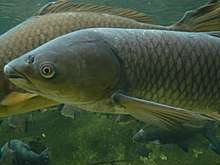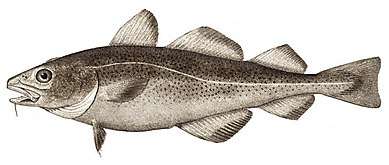Grass carp
The grass carp (Ctenopharyngodon idella) is a large herbivorous freshwater fish species of the family Cyprinidae native to eastern Asia, with an original range from northern Vietnam to the Amur River on the Siberia-China border.[1] This Asian carp is the only species of the genus Ctenopharyngodon.
| Grass carp | |
|---|---|
 | |
| Scientific classification | |
| Kingdom: | Animalia |
| Phylum: | Chordata |
| Class: | Actinopterygii |
| Order: | Cypriniformes |
| Family: | Cyprinidae |
| Subfamily: | Squaliobarbinae |
| Genus: | Ctenopharyngodon Steindachner, 1866 |
| Species: | C. idella |
| Binomial name | |
| Ctenopharyngodon idella (Valenciennes in Cuvier & Valenciennes, 1844) | |
| Synonyms | |
| |


It is cultivated in China for food, but was introduced in Europe and the United States for aquatic weed control, becoming the species of fish with the largest reported production in aquaculture globally, over five million tonnes per year.[2]
The grass carp is a fish of large, turbid rivers and associated floodplain lakes, with a wide degree of temperature tolerance. Grass carp will enter reproductive condition and spawn at temperatures of 20 to 30 °C (68 to 86 °F).[1][3]
Appearance and anatomy
Grass carp have elongated, chubby, torpedo-shaped body forms. The terminal mouth is slightly oblique with non-fleshy, firm lips, and no barbels.[4] The complete lateral line contains 40 to 42 scales. Broad, ridged, pharyngeal teeth are arranged in a 2, 4-4, 2 formula. The dorsal fin has eight to 10 soft rays, and the anal fin is set closer to the tail than most cyprinids. Body color is dark olive, shading to brownish-yellow on the sides, with a white belly and large, slightly outlined scales.
The grass carp grows very rapidly. Young fish stocked in the spring at 20 cm (7.9 in) will reach over 45 cm (18 in) by fall. The average length is about 60–100 cm (23.5–39.5 in). The maximum length is 2.0 m (6.6 ft) and they grow to 45 kg (99 lb). According to one study, they live an average of five to 9 years, with the oldest surviving 11 years. In Silver Lake Washington there is a thriving population of grass carp passing the 15-year mark.[5] They eat up to three times their own body weight daily. They thrive in small lakes and backwaters that provide an abundant supply of freshwater vegetation.
Ecology
This species occurs in lakes, ponds, pools, and backwaters of large rivers, preferring large, slow-flowing or standing water bodies with vegetation.[4] In the wild, grass carp spawn in fast-moving rivers, and their eggs, which are slightly heavier than water, develop while drifting downstream, kept in suspension by turbulence. The eggs are thought to die if they sink to the bottom.[6]
Adults of the species feed primarily on aquatic plants. They feed on higher aquatic plants and submerged terrestrial vegetation, but may also take detritus, insects, and other invertebrates.[1][7]
Introduced species
Grass carp have been introduced to many countries around the world. In the Northern Hemisphere, countries and territories of introduction include Taiwan, Israel, Japan, the Philippines, the United States, Mexico, India, Malaysia, the Netherlands, Switzerland, Czech Republic, Slovakia, Croatia, Serbia, Slovenia, Montenegro, Bosnia and Herzegovina, Macedonia, Denmark, Sweden, Romania, Poland, Italy, Germany, France, and the United Kingdom. In the Southern Hemisphere, they have been introduced to Argentina, Venezuela, Fiji, New Zealand, Australia, and South Africa. Grass carp are known to have spawned and established self-reproducing populations in only six of the many larger Northern Hemisphere rivers into which they have been stocked. Their failure to establish populations in other rivers suggests they have quite specific reproductive requirements.[8]
In the United States, the species was first imported in 1963 from Taiwan and Malaysia to aquaculture facilities in Alabama and Arkansas.[9] The first release is believed to have been an accidental escape in 1966 from the US Fish and Wildlife Service's Fish Farming Experimental Station in Stuttgart, Arkansas, followed by planned introductions beginning in 1969.[9][10] Subsequently, there have been widespread authorized, illegal, and accidental introductions; by the 1970s the species had been introduced to 40 states, and it has since been reported in 45 of the country's 50 states.[9][10] In 2013 it was determined to be reproducing in the Great Lakes Basin.[11] It is still stocked in many states as an effective biocontrol for undesirable aquatic vegetation,[9][10] many species of which are themselves introduced.
Grass carp require long rivers for the survival of the eggs and very young fish.
Use as weed control

Grass carp were introduced into New Zealand in 1966 to control the growth of aquatic plants. Unlike the other introduced fish brought to New Zealand, the potential value and impact of grass carp was investigated in secure facilities prior to their use in field trials.[12] They are now approved by the New Zealand government for aquatic weed control, although each instance requires specific authorization.[13] In the Netherlands the species was also introduced, in 1973, to control over-abundant aquatic weeds. The release was controlled and regulated by the Dutch Ministry of Agriculture, Nature and Food Quality.
In both of these countries, control is made easier by the fact that grass carp are very unlikely to naturally reproduce because of their very specific breeding requirements,[13] but elsewhere control is obtained by the use of sterile, triploid fish.[10][14]
Fishing for grass carp

Grass carp grow large and are strong fighters on a rod and reel, but because of their vegetarian habits and their wariness, they can be difficult to catch.[15] The IGFA World record for a grass carp caught on line and hook is 39.75 kg, (87.6 lb) caught in Bulgaria in 2009.[16]
Where grass carp populations are maintained through stocking as a biocontrol for noxious weeds, fishers are typically asked to return any caught to the water alive and unharmed.
The fish are popular among bowfishers where bowfishing for them is legal.
References
- Mandrak and Cudmore. 2004. Biological Synopsis of Grass Carp (Ctenopharyngodon idella) Archived 2011-07-06 at the Wayback Machine.
- World aquaculture production of fish, crustaceans, mollusks, etc., by principal species in 2013 FAO Yearbook of Fisheries Statistics 2014
- Shireman, J.V. and C.R. Smith. 1983. Synopsis of biological data on the grass carp, Ctenopharyngodon idella (Cuvier and Valentines, 1844). Food and Aquaculture Organization Synopsis. 135: 86pp.
- Grass carp in fishbase.org.
- Kirk and Socha. Longevity and Persistence of Triploid Grass Carp Stocked into the Santee Cooper Reservoirs of South Carolina. J. Aquat. Plant Manage. 41:2003.
- Krykhtin, M.L., and E.I. Gorbach. 1981. Reproductive ecology of the grass carp, Ctenopharyngodon idella, and the silver carp, Hypophthalmichthys molitrix, in the Amur Basin. Journal of Ichthyology 21(2):109-123.
- Froese, Rainer and Pauly, Daniel, eds. (2007). "Ctenopharyngodon idella" in FishBase. May 2007 version.
- Rowe, D. K., & Schipper, C. M. (1985). An assessment of the impact of grass carp (Ctenopharyngodon Idella) in New Zealand waters. Rotorua N.Z.: Fisheries Research Division, Ministry of Agriculture and Fisheries.
- Nico, L.G.; Fuller, P.L.; Schofield, P.J.; Neilson, M.E. (15 March 2012). "Grass Carp (Ctenopharyngodon idella)". Nonindigenous Aquatic Species (NAS) database. Gainesville, FL: United States Geological Survey. Retrieved 12 January 2014.
- Canover, G; Simmonds, R; Whalen, M, eds. (November 2007). Management and Control Plan for Bighead, Black, Grass, and Silver Carps in the United States (PDF). Washington, DC: Asian Carp Working Group, Aquatic Nuisance Species Task Force. pp. 21–27.
- Chapman, Duane C.; Davis, Jeremiah J.; Jenkins, Jill A.; Kocovsky, Patrick M.; Miner, Jeffrey G.; Farver, John; Jackson, P. Ryan (2013). "First evidence of grass carp recruitment in the Great Lakes Basin". Journal of Great Lakes Research. 39 (4): 547–554. doi:10.1016/j.jglr.2013.09.019. ISSN 0380-1330.
- Grass carp in niwa.co.nz.
- "Grass carp for weed control", DOC
- "Triploid Grass Carp Information", texas.gov
- Catching Grass Carp Archived 2010-05-28 at the Wayback Machine. Missouri Department of Conservation.
- "Grass carp", IGFA Online. Retrieved 22 June 2016.
External links
| Wikimedia Commons has media related to Ctenopharyngodon idella. |
- Species Profile - Grass Carp (Ctenopharyngodon idella), National Invasive Species Information Center, United States National Agricultural Library. Lists general information and resources for Grass Carp.
- Valid species list of genus Ctenopharyngodon on FishBase.
- "Ctenopharyngodon idella". Integrated Taxonomic Information System. Retrieved 11 March 2006.


.png)
